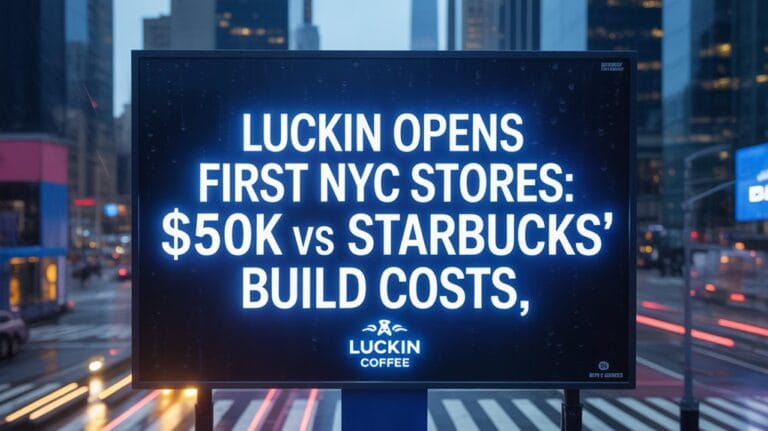Chinese Coffee Giant Invades America
While Starbucks grapples with declining sales in China, homegrown rival Luckin Coffee brews plans to challenge its U.S. dominance. The Chinese expansion success story begins with Luckin overtaking Starbucks as China’s largest coffee chain by revenue in 2023, a stunning reversal in coffee competition. By Q1 2024, Luckin had 18,590 stores in China—adding over 2,300 outlets in three months—while Starbucks’ China sales dropped 11% the same quarter. The American chain faced customer service backlash after a viral video showed staff demanding purchases for seating access, which accumulated over 60 million views on Chinese social media.
Luckin’s rapid growth reflects aggressive pricing and tech-focused tactics: small stores, app-based orders, and prices 15-20% below Starbucks, targeting price-sensitive Chinese consumers. Its 2023 revenue hit $3.45 billion, surpassing Starbucks’ China earnings for the initial time.
With tech-driven efficiency and prices 15-20% below Starbucks, Luckin surged to $3.45B revenue, dethroning Starbucks as China’s coffee king in 2023.
The battle extends beyond China’s borders. Luckin aims to hit 50,000 global stores, launching international outposts in Singapore and Malaysia by late 2024. The company recently opened its first two U.S. locations in New York City, testing its low-cost store model with $50,000 build-out costs versus Starbucks’ $700,000 average. Though no U.S. stores exist yet, analysts see groundwork in its supply chain moves. The company signed a $1.38 billion deal for Brazilian coffee beans through 2029 and built massive roasting plants in Suzhou and Qingdao. Vertical integration helps keep costs low, a strategy potentially replicable abroad.
Starbucks, meanwhile, operates over 17,000 U.S. stores but faces pressure to defend its home turf. Market dynamics tilt toward high-volume, low-cost models. Both chains now focus on enhancing transactions rather than raising prices—Starbucks’ average China order price fell 8% in Q1 2024.
Luckin’s 87% revenue jump in 2023 came despite China’s per capita coffee consumption remaining low at 11 cups yearly. Urbanization and younger drinkers drive demand, with China’s coffee market doubling since 2020 to $22.4 billion. Both brands push into smaller cities, where 66,920 new cafés opened last year.
U.S. entry poses challenges. Luckin must adapt to saturated markets and different consumer habits. Its app-driven model worked in China’s mobile-first culture but may clash with established U.S. preferences. Yet its ability to scale rapidly—10,000 stores in six years—shows operational muscle.
Analysts warn Starbucks’ U.S. dominance isn’t easily shaken, but Luckin’s playbook—fueled by $870 million in Q1 2024 revenue—proved doubters wrong once. As coffee wars go global, the next front may brew stateside.

